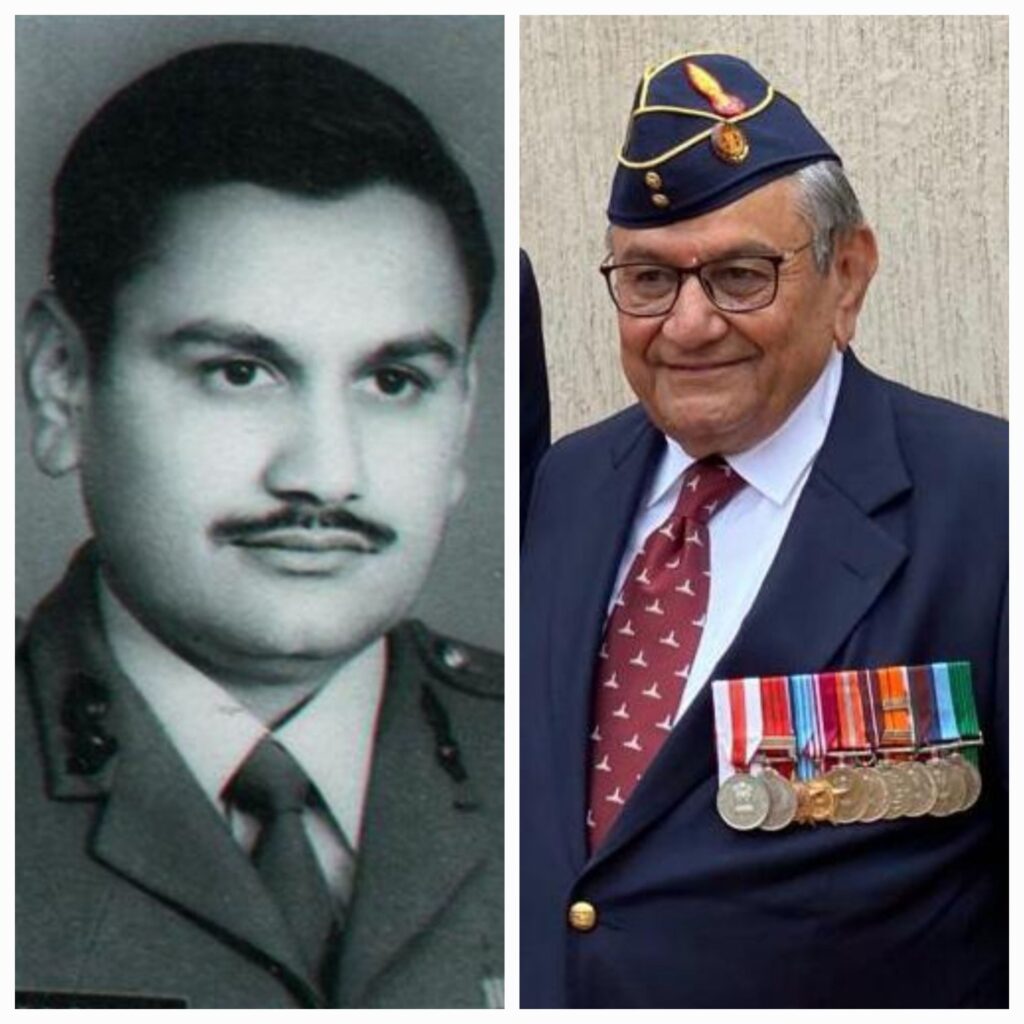By: Lt Col JS Sodhi (Retd), Editor, GSDN

The quote “The soldier, above all other people, prays for peace, for he must suffer and bear the deepest wounds and scars of war” is apt for Major Kamlesh Bajaj (Retired) who suffered serious injuries during the 1965 India-Pakistan War and has since lived with a shrapnel embedded in his left elbow which till date has a broken bone, since surgery would entail amputation of his left arm.
Born on May 09, 1939 in Bijnore in the Indian city of Uttar Pradesh, Major Kamlesh Bajaj did his schooling in St. Joseph’s Academy, Dehradun which was then one of the few residential schools in India. It was in this period that the young Kamlesh saw the Joint Servies Wing (JSW) being established and the cadets of JSW whilst on liberty to Dehradun on Sundays & Holidays, left an indelible impression on Kamlesh in their smart uniforms and good military bearing. It was then Kamlesh decided to join the JSW.
In 1954, Kamlesh Bajaj appeared for the entrance examination of the 13 JSW course having just made it to the qualifying criteria as the cut-off birth date for the examination was June 30, 1939! Needless to say, Kamlesh Bajaj became the youngest cadet of 13 JSW course after clearing the highly competitive selection process that included interview and medicals apart from the written examination.
On December 07, 1954 the Joint Services Wing transitioned to National Defence Academy (NDA) and on January 16, 1955 the NDA was formally inaugurated in Khadakwasla, Pune.
The senior cadets already undergoing training in JSW in Dehradun moved to NDA in Khadakwasla and the 13 NDA course became the first course in the history of NDA to report in the newly constructed academy for the first term. Cadet Kamlesh Bajaj was amongst them and was allotted How Squadron which later on came to be renamed as Hunter Squadron.
Having studied in a residential school, Cadet Kamlesh Bajaj adapted to the tough and rigorous training of the NDA with relative ease and in the third term was transferred to the newly raised King Squadron, later renamed as Kilo Squadron.
In December 1957, Cadet Kamlesh Bajaj passed out of the NDA after three years of training and proceeded to the Indian Military Academy (IMA), Dehradun for the final one year of the pre-commissioning training. In IMA, Gentleman Cadet (GC) Kamlesh Bajaj was allotted Cassino Company. In the final semester of training in IMA, GC Kamlesh Bajaj was appointed the Company Sergeant Major (CSM). The appointment of CSM is a very prestigious appointment and only the best cadets based on their previous performance in various aspects of training are made the CSMs. On the shoulders of CSM rests the administrative and training responsibilities of the entire Company which is reflected in various competitions and camps that the Company takes part in.
On December 14, 1958 CSM Kamlesh Bajaj passed out from IMA and was commissioned in The Bombay Sappers of the Corps of Engineers in the Indian Army. At a young age of just over 19 years, Second Lieutenant (2/Lt) had joined the finest organisation in the world – The Indian Army. The dream he had in his eyes as a student in the school in Dehradun had fructified in Dehradun itself!
In 1959, After the mandatory six months Young Officers (YOs) Course in the College of Military Engineering (CME), Pune followed by six months compulsory attachment in the Bombay Engineer Group & Centre, Pune, which was a must for every YO commissioned in the Bombay Sappers as was for the other two Sappers – Bengal Sappers in Roorkee and Madras Sappers in Bengaluru, 2/Lt Kamlesh Bajaj proceeded for the two-and-a-half year degree course in CME from 1960-62.
In December 1961, Operation Vijay was launched by India to liberate Goa from the yoke of the Portuguese rule. The degree course of Lieutenant (Lt) Kamlesh Bajaj was held in abeyance and he and his course-mates were posted to various Field Companies (Fd Coys) to take part in the war that lasted from December 17-19, 1961. Lt Kamlesh Bajaj as part of 482 Fd Coy constructed a bridge in Vanastriam in Goa to facilitate the crossing of armoured tanks.
After India’s victory over Portugal in Operation Vijay, as orders came for de-induction, Lt Kamlesh Bajaj purchased a Philips radio in Goa for Rs 300, then a princely sum.
After completing the degree course in CME, Lt Kamlesh Bajaj was posted as the Adjutant of 25 Division Engineers on the Line of Control (LOC) in Jammu & Kashmir on the borders with Pakistan as a Captain (Capt). It was during this time that Capt Kamlesh Bajaj married Harshi, a bond that would last for 58 years till Harshi Bajaj passed away in 2020.
After the two-year tenure on the LOC, Capt Kamlesh Bajaj was posted as the Centre Adjutant in BEG & Centre, Khadki, Pune from April 1964 to June 1965. In mid-1965, Major (Maj) Kamlesh Bajaj was given the command of 20 Fd Coy as part of the Infantry Brigade in Akhnoor, Jammu & Kashmir.
Tensions between India and Pakistan were increasing and as the war clouds started darkening, Maj Kamlesh Bajaj was tasked to construct a Class 50/60 Tonnes captive ferry on the River Chenab to ferry across one squadron of tanks of 20 Lancers to Chamb sector. Also, a smaller ferry of Class 5 Tonnes was to be constructed on River Munawar Tawi in Chamb for ferrying war-like stores to the forward troops deployed on the LOC.
20 Fd Coy under the command of Maj Kamlesh Bajaj swung into action to execute both the tasks assigned which had immense operational significance. At this time the Pakistan Army started intermittent shelling which continued non-stop. With utter disregard to personal safety and minimal rest, Maj Kamlesh Bajaj led from the front and under tough and trying conditions and circumstances, both the assigned tasks were completed. Soon, infiltration started across Pakistan and 20 Fd Coy was given the additional task of mine laying in Chamb sector.
Build-up for the war had commenced.
On September 01, 1965 Pakistan struck. The Pakistan Air Force (PAF) started strafing Indian military targets and among them was the Chamb sector. The Indian Air Force (IAF) started operations at 4.30 pm the same day in Chamb sector with the River Munawar Tawi as the forward edge of the bomb line.
On September 01, 1965 Pakistan had the upper edge over India in the Chamb sector. Soon orders were issued to the Infantry Brigade comprising 20 Fd Coy for a tactical withdrawal to the Jaurian sector. 20 Fd Coy later was amalgamated in 110 Engineer Regiment.
At around 6 am on September 02, 1965 as Maj Kamlesh Bajaj was discussing with a Brigade Headquarters officer the withdrawal route on a map spread over a Willys Jeep bonnet, PAF fighter aircrafts started strafing this area and a shrapnel hit the left elbow of Maj Kamlesh Bajaj. As he fell on the ground due to the impact, his back was hit by another shrapnel that pierced his spine.
Bleeding profusely from his left arm and back, Maj Kamlesh Bajaj though writhing badly in pain, self-consoled his being alive. Seconds later, a Junior Commissioned Officer (JCO) crawled to his Company Commander and in a fireman’s lift, evacuated Maj Kamlesh Bajaj to safety and eventually to Military Hospital, Jammu.
The Army Doctors in Jammu realising the gravity of injuries sustained by Maj Kamlesh Bajaj and the scarce chances of his survival, transferred him to Military Hospital (later Command Hospital), Lucknow which had better medical care. It was here that Major Kamlesh Bajaj was told by the operating surgeons that though they had extracted the shrapnel in the spine, but the shrapnel in the left elbow would remain forever as attempt to remove it would risk the loss of the left arm.
Major Kamlesh Bajaj had to choose one of the options, either risk the amputation of his left arm or live with the shrapnel embedded. He chose the latter. And till date he has pain in left elbow, at times very excruciating.
While recuperating, Sapper Mata Prasad, the buddy of Maj Kamlesh Bajaj came to visit him in Lucknow and on meeting him, the first this he did after saluting was to give the Philips radio that had been purchased during the war in Goa! Relations between the Indian Army officers and soldiers are exemplary and go much beyond the call of duty.
Being downgraded as a permanent medical category with no scope for further promotions and the life-long pain in his left elbow, Major Kamlesh Bajaj took premature retirement from the Indian Army on April 14, 1979.
Thereafter, he worked for 16 years in the Middle East where he executed many construction projects which included the US$ 1 billion Al-Khobar residential project in Saudi Arabia and the Atlantis Hotel in Dubai. And, for 2 years he constructed a world-famous resort in Maldives. Major Kamlesh Bajaj (Retired) in now settled in Pune, Maharashtra where he leads a retired life with the constant pain in his left elbow.
The saying “Some people think that to be strong is never to feel pain. In reality, the strongest people are the ones who feel it, understand it, and accept it” holds very true for Major Kamlesh Bajaj (Retd).

Lt Col JS Sodhi (Retd) is the Founder-Editor, Global Strategic & Defence News and has authored the book “China’s War Clouds: The Great Chinese Checkmate”. He tweets at @JassiSodhi24.


Excellent write-up! Thanks.👍